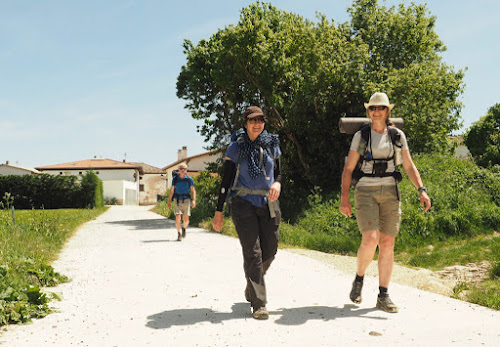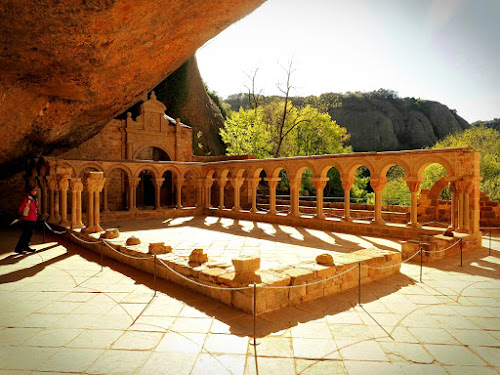After last night's ten-in-a-room albergue accommodation complete with dysfunctional shower and dodgy kitchen we were in the mood for something a little more comfortable, so before we left Sanguesa in the morning we went past the friendly tourism office and booked ourselves a room at a casa rural in our next stopover, Monreal. Accommodation on the Camino is generally a gamble so we wanted to make sure we are assured of a good night's sleep. Little did we know about the added benefits we were tying down, but I'm getting ahead of myself.
We started the day's walk by going over the bridge crossing the Aragon river and pausing on the opposite side to look for the Roman funerary stone built into the bridge pillar. And sure enough, there it was, a weather-worn, grey square of granite with the inscription: 'Carolina built this tomb for herself and her two sons, Felix and Firma'. It always sends me on an imaginary journey when I see things like this. Two thousand years, not close from here, a woman named Carolina went into a stonemason's workshop and ordered a gravestone that is now cemented into a bridge pillar, where it will probably remain for another two thousand years. Isn't that an amazing thought?
On the theme of things Roman, the first village we passed through, the scenic Rocaforte, was founded by the Romans during their reign here. I could see why - location, location, location. Rocaforte is set high against the ridge of a prominent hill with a view over the valley to die for. Well, it had a great view back then, but now most of the snazzily rebuilt village faced the smoking chimneys of the smelly paper factory on the outskirts of Sanguesa. What would the Roman aristocrats saybout that?
Then it was a long stretch of walking through the countryside with two or three quiet villages serving as distance markers and water replenishing points. All was going swimmingly when I suddenly had my rainbow-coloured Camino bubble popped.
We were a kilometer or two out of the vollage of Ibargoiti when we saw a pop-up cafe next to the path - two of three umbrellas with chairs and tables, and a guy in a mobile kiosk selling everything from blister plasters to fizzy drinks and cigarettes.
Though we're not due for a stop, I'm thinking, we should support the local struggling Spanish economy, it's just the right Camino thing to do. So I go through the complex ritual of removing my backpack, fish out a five Euro note, walk over to the kiosk and order two tiny paper cups of orange juice. And I mean t.i.n.y. He takes the fiver, pops it into a box, hands me two cups, and turns his attention to the next customer. I meekly make a gesture showing I'm waiting for my change, but he off-handedly points to an equally tiny sign saying I've just paid five Euros for two sips of juice. He then shoots me a cocky 'do your worst amigo' look and that was that.
I'd just been handed a raw deal on the Camino.
I let it go. I believe in karma. You lose some, you win some. We won in Jaca, where we were blessed with nice, free croissants at that cute little coffee shop. Anyway, word will soon get out on social media about this smooth operator, and then he'll be torn to bits by the cyber-wolves and left wondering why no-one is ordering orange juice anymore. Facebook and Twitter can be horribly wrathful.
Soon after continuing we bumped into the two pilgrims we met at Ruesta. They're phenomenal walkers and set a blistering pace, and with the wheels oiled by with the stimulating conversation time flew by and we arrived in Monreal earlier than we anticipated.
Our bed for the night turned out to be a chic little place in the middle of town, decorated straight from a country living magazine. The owner is clearly a cultured city boy made good, living his dream in this corner of rural Spain.
Which made us happy too, especially during dinner. Imagine a three star Michelin chef preparing that old Camino favourite, the peregrino menu. We started with the smoothest leek and potato soup I had ever tasted, followed by the most delicious tofu in tomato for me, and Adeline had an equally tasty black squid. Then followed something truly remarkable: Chocolate tart with complementing anice seed tea. I stood up from dinner, went back to our room and wrote the most glowing culinary review Tripadvisor has ever seen. I hope every foodie pilgrim that passes through Monreal stays at Etxartenea. The place is a pilgrimage in itself.






















